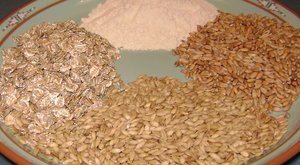| 4 gluten sources. Top: High-gluten wheat flour. Right: European spelt. Bottom: Barley. Left: Rolled rye flakes. (Photo credit: Wikipedia) |
Is Quinoa Truly Gluten-Free?
Yes, quinoa is a gluten-free food. Because quinoa is a seed, not a grain, the structure of quinoa is totally different from that of grain. For people who are on a strict gluten-free diet, concerns about cross-contamination with airborne wheat or other grains containing gluten can be put to rest. This is due to the fact that most of the world's quinoa supply, which comes from the Ancient Harvest Company, is grown at an elevation of over 12,000 feet in Bolivia. Because of this high altitude, gluten-bearing grains cannot survive, meaning that cross-contamination with gluten grains does not occur. As you can see, it is easy to go gluten free using quinoa as a good source of nutrition. Let's examine a few other reasons why going gluten free can be simple using quinoa.
Protein
Quinoa is packed with protein, containing all 9 essential amino acids. It is also believed to be easier for the body to digest quinoa than most other plant-based proteins. Milk has a similar protein structure, which the body is designed to utilize. The intolerance that some people have for milk is actually caused by the difficulty breaking down the lactose in the milk, not the protein structures. Giving your body a bunch of fuel to run on throughout your day requires protein, and quinoa is a great way to go, and keep going.
Essential Fats And Vitamins
Quinoa is a good source of Omega 3 and Omega 6, the essential fatty acids our body and brain needs to function correctly. You'll also find quinoa to be a rich source of Vitamin E. You'll recognize these healthy components in just about every age-reducing cream you see in the drugstore. Add to the list the all important antioxidants, folate, and B vitamins that you'll get and you have a healthy powerhouse in quinoa. Eating gluten-free certainly doesn't mean you have to miss out on any nutrition, at least when you add quinoa to your diet.
Minerals
Quinoa is particularly high in manganese and is also a good source of magnesium. These two minerals combined helps support a healthy immune system and synthesize fatty acids and cholesterol. Quinoa also has increased levels of iron and copper which are basic necessities for healthy blood supply. You'll also find phosphorus, zinc, and even a little calcium thrown into the mix. Eating quinoa as a regular part of your gluten-free diet can certainly replace and boost your nutrition.
| Recipe Idea: Quinoa-Crusted Scallop (Photo credit: ulterior epicure) |
Gluten free diets usually come with their own challenges. One of those challenges is finding a way to reduce your intake of carbohydrates. This often leads to using rice more often. However, a cup of cooked white rice has about 44 net grams of carbs (that's total carbs minus dietary fiber.) A cup of cooked brown rice has about 41 net grams of carbs. Compared to a cup of cooked quinoa at about 34 net grams of carbs, the choice to eat quinoa could make sense. Now, eating quinoa doesn't save extreme amounts of carbs, but if you replace rice with quinoa in your favorite recipes routinely, over time you will be saving quite a bit. If you are looking for ways to lower your carb intake while eating gluten-free, substituting quinoa for some of the rice you use is probably a wise decision.
There are so many reasons to go gluten-free with quinoa. Whether you are looking to increase your protein, healthy fats, or maintain a healthy blood supply, quinoa is the newest food to add to your diet. If your desire is to cut down the amount of carbohydrates you are taking in on your current gluten-free diet, then quinoa is your go-to food. Making the transition to a gluten-free diet is the easiest move in the world as long as you have quinoa on your plate.
And if you're not sure how to cook or use it, don't worry - we'll share plenty of yummy quinoa recipes on this blog!



No comments:
Post a Comment
We welcome comments and suggestions!